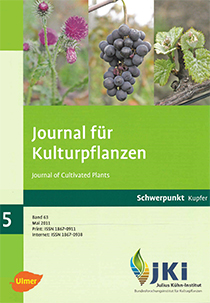Monitoring of total contents of copper in organically and conventionally managed soils. Part 1: Total contents in vineyard soils of German quality vine areas
DOI:
https://doi.org/10.5073/JfK.2011.05.01Keywords:
Total contents of copper, control of fungi, vine-Peronospora, Plasmopara viticola, organically and conventionally managed vineyard soils, load situation in viticulture, risk potential, exposure assessment, preselection of adequate monitoring areasAbstract
The samplings carried out in the years 2009 and 2010 were designed to provide a survey of the copper contents of soils of vine culturing regions in Germany. The data base received may be used for additional more specific surveys and the identification of sites appropriate for long term monitoring as well. It is also considered as a prerequisite for the identification of sites suitable for the assessment of effects of copper soil contamination to soil dwelling organisms in terms of the ‟strategy paper concerning further copper application in agriculture, especially in organic farming.”
2087 single samples from the soil horizon to 5 cm and to 20 cm were taken from 85 ecologically and conventionally managed vine yards. The sampling aims to get a representative survey of load distribution as a prerequisite of a monitoring program to be performed on selected sampling locations combining exposure analysis and identification of sensitive indicator species of the particular earthworm coenoses. On the basis of total contents, copper load and distribution on test and reference areas of German cultivation sites is shown. The influence of plant cover between the rows on the copper distribution pattern in the soil horizons to 5 cm and to 20 cm and the differences of samples taken along the cultivation rows and between them is discussed.
Samples were taken from 56 ecologically and 29 conventionally managed sites, consisting of an area under cultivation (test area), an area having been under cultivation in the past (reference), an area never having been under cultivation indicating natural occurrance (control).
Total copper contents of test and reference areas (581 soil samples) from the soil horizon 0–20 cm were analyzed and presented as minimum, maximum, mean and percentiles.
The load distribution survey in combination with management history and literature data verifies that load peaks result from high copper input in the years 1890 to 1940, when up to 50 kg copper per ha and year was applied to control fungal diseases in viticulture.
By means of the data, generated in the survey concerning load situation, site description and duration of management, 15 cultivation sites representing by their properties a typical site, and fulfilling the site specific requirements for a biological sampling on species abundance of lumbricidae are proposed as an instrument of risk assessment for soil dwelling organisms.
The transfer of knowledge into practice is ensured by close co-operation with organic farming associations and expert discussions with involved institutions. The derived contamination scenario will be provided to agencies taking part in the authorization process.
Downloads
Published
Issue
Section
License
The content of the journal is licensed under the Creative Commons Attribution 4.0 License. Any user is free to share and adapt (remix, transform, build upon) the content as long as the original publication is attributed (authors, title, year, journal, issue, pages).
The copyright of the published work remains with the authors. The authors grant the Journal of Cultivated Plants, the Julius Kühn-Institut and the OpenAgrar repository the non-exclusive right to distribute and exploit the work.







